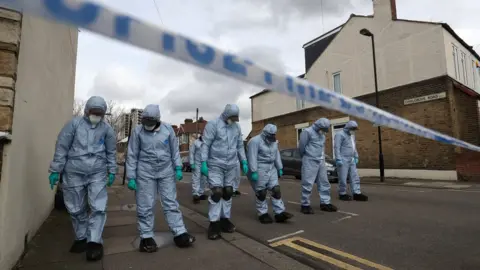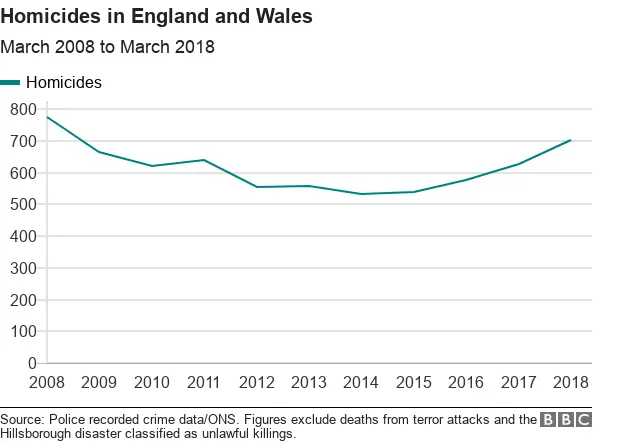No-one charged in 9 out of 10 crimes - Home Office
 PA
PAOnly 9% of crimes end with suspects being charged or summonsed in England and Wales, Home Office figures suggest.
In the 12 months to March, 443,000 crimes resulted in a charge or summons out of 4.6 million offences - the lowest detection rate since 2015.
Data also shows police closed nearly half (48%) of all cases because no suspect could be identified.
It comes as new figures show the number of homicides has increased for the fourth year running.
The Home Office statistics on crime outcomes are published at the same time as quarterly crime figures and the Crime Survey for England and Wales, which is based on people's experiences of crime.
The changing picture of how successfully police are catching criminals comes against a backdrop of rising crime.
Overall, crimes recorded by police went up 11% in the year to March, figures published by the Office for National Statistics suggested.
The Home Office said that along with a growing caseload, there was evidence to suggest that more recorded crimes were in the most challenging offence types to investigate.
It gives the example of sexual offences - up 24% on last year - giving officers a bigger workload and becoming more complex.
Rape cases take an average of 129 days to solve compared with, for example, two days for theft or criminal damage.
The Home Office figures show a continuing downward trend since 2015 in the proportion of cases police have resolved, falling from 15 to 9%.
They also showed a fall in the number of cautions and penalty notices served to adults and young people - from about 112,00 in the 12 months to March 2017 down to 88,000 a year later.
Ché Donald, of the Police Federation, which represents rank-and-file officers, said the new figures were proof that policing in the UK was "on the critical list".
"We are sleepwalking into a nightmare," he said.

Other notable findings from the Home Office include:
- In sexual offence cases, only 5% resulted in someone being charged or summonsed
- That figure falls to 3% for rape cases. In about a third (34%) of rape cases, the victim did not want to take the case to its conclusion
- In all, one in five cases went unresolved because the victim did not support action, usually meaning they did not want to go through the courts
- Three quarters of theft cases were closed with no suspect identified
- This was also the case in more than half (57%) of robberies, including muggings

Analysis: A vicious circle of crime?
 Getty Images
Getty ImagesBy BBC home affairs correspondent Danny Shaw
These figures paint a gloomy picture. Not only are police recording more crimes - but they're solving fewer of them.
That's partly because proportionately more of the offences they have to deal with are complex and difficult to investigate, such as rape.
But it may also be a reflection of the decline in police officer numbers since 2010, down by a further 738 according to the latest workforce data, and the national shortage of detectives, as the Inspectorate of Constabulary has highlighted.
The consequences are serious: victims not getting the justice they deserve, public confidence in the criminal justice system damaged and more offenders avoiding detection - and free to commit further crimes.
It threatens to become a vicious circle of crime.

Meanwhile, the latest figures for recorded offences showed homicides in England and Wales were up 12% in the 12 months to the end of March, from 627 to 701.
Homicide covers cases of murder, manslaughter, corporate manslaughter and infanticide, but these figures exclude terror attacks.
The Office for National Statistics (ONS) said homicide remained rare and tended to take place in London and other cities.
The start of 2018 was characterised by what appeared to be regular killings on the streets of London.
Between January and March, the BBC recorded 46 killings in the city - some from gunshot wounds but most from stabbings. Among those killed were a handful of teenagers.

The data also showed:
- Knife crime up 16%
- Robbery offences, including muggings, up 30% - 77,103 cases were recorded in the 12 months to March. In February, the BBC reported that the "rich pickings" on Oxford Street in London's West End had made it a hotspot for robberies and ride-by moped thefts
- Vehicle-related thefts up 12% - it is the second year for vehicle-related theft numbers to rise and is backed up by the separate Crime Survey which showed an increase of 17%
Publishing the data, the ONS said: "Over recent decades, we've seen a fall in overall levels of crime, a trend that now looks to be stabilising."
Caroline Youell, of the ONS, said the latest figures showed a "fairly stable" picture in England and Wales for most crime types.
"It is too early to say if this is a change to the long-term declining trend," she added.
"There have been increases in some lower-volume 'high-harm' offences such as homicide and knife crime, consistent with rises over the past three years.
"However, the latest rise in gun crime is much smaller than previously seen.
"We have also seen continued increases in some theft offences such as vehicle-related theft and burglary, while computer viruses have fallen."
Privacy and methodology
The BBC uses the postcode you enter here to determine the police force area you live in but does not store this data. The BBC is the data controller of the data you enter here. If you have any questions about how we process data, please read our Privacy and Cookies Policy.
